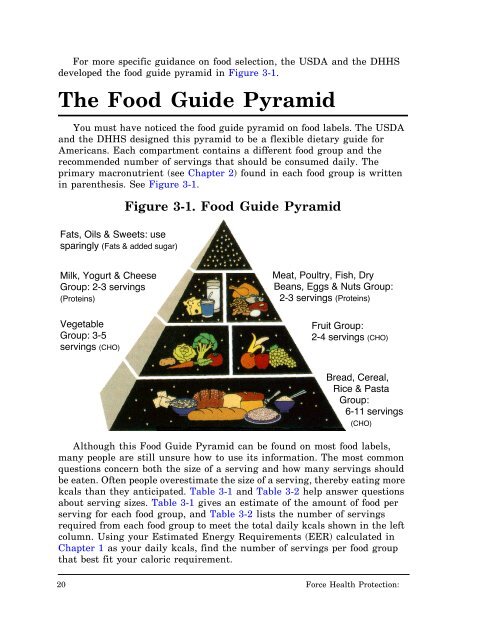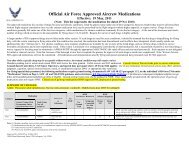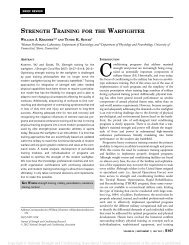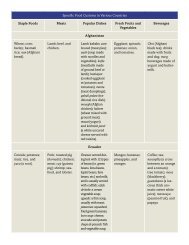Force Health Protection: Nutrition and Exercise Resource Manual
Force Health Protection: Nutrition and Exercise Resource Manual
Force Health Protection: Nutrition and Exercise Resource Manual
Create successful ePaper yourself
Turn your PDF publications into a flip-book with our unique Google optimized e-Paper software.
For more specific guidance on food selection, the USDA <strong>and</strong> the DHHS<br />
developed the food guide pyramid in Figure 3-1.<br />
The Food Guide Pyramid<br />
You must have noticed the food guide pyramid on food labels. The USDA<br />
<strong>and</strong> the DHHS designed this pyramid to be a flexible dietary guide for<br />
Americans. Each compartment contains a different food group <strong>and</strong> the<br />
recommended number of servings that should be consumed daily. The<br />
primary macronutrient (see Chapter 2) found in each food group is written<br />
in parenthesis. See Figure 3-1.<br />
Figure 3-1. Food Guide Pyramid<br />
Fats, Oils & Sweets: use<br />
sparingly (Fats & added sugar)<br />
Milk, Yogurt & Cheese<br />
Group: 2-3 servings<br />
(Proteins)<br />
Meat, Poultry, Fish, Dry<br />
Beans, Eggs & Nuts Group:<br />
2-3 servings (Proteins)<br />
Vegetable<br />
Group: 3-5<br />
servings (CHO)<br />
Fruit Group:<br />
2-4 servings (CHO)<br />
Bread, Cereal,<br />
Rice & Pasta<br />
Group:<br />
6-11 servings<br />
(CHO)<br />
Although this Food Guide Pyramid can be found on most food labels,<br />
many people are still unsure how to use its information. The most common<br />
questions concern both the size of a serving <strong>and</strong> how many servings should<br />
be eaten. Often people overestimate the size of a serving, thereby eating more<br />
kcals than they anticipated. Table 3-1 <strong>and</strong> Table 3-2 help answer questions<br />
about serving sizes. Table 3-1 gives an estimate of the amount of food per<br />
serving for each food group, <strong>and</strong> Table 3-2 lists the number of servings<br />
required from each food group to meet the total daily kcals shown in the left<br />
column. Using your Estimated Energy Requirements (EER) calculated in<br />
Chapter 1 as your daily kcals, find the number of servings per food group<br />
that best fit your caloric requirement.<br />
20 <strong>Force</strong> <strong>Health</strong> <strong>Protection</strong>:






![Body Composition and Military [PDF] - Human Performance ...](https://img.yumpu.com/43269347/1/190x245/body-composition-and-military-pdf-human-performance-.jpg?quality=85)
![Tips for Grocery Shopping [PDF]](https://img.yumpu.com/37447379/1/190x245/tips-for-grocery-shopping-pdf.jpg?quality=85)



![Synthetic Drugs [PDF] - Human Performance Resource Center](https://img.yumpu.com/37447322/1/190x245/synthetic-drugs-pdf-human-performance-resource-center.jpg?quality=85)


